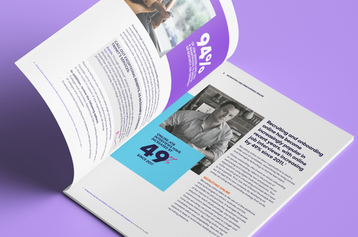
Table of contents
- 1.Maximize the Onboarding Experience
- 2.Compliance
- 3.Clarification
- 4.Culture
- 5.Connection
- 6.Try to See Things from the Employee Perspective
- 7.Ask the Right Questions
- 8.Focus on Individual Strengths
- 9.Lead Like a Coach, Not Like a Boss
- 10.Identify Barriers to Improvement
- 11.Work as a Team
- 12.Give, and Receive, Frequent and Consistent Feedback
- 13.Empower Your Employees
For an employer, hiring the most qualified and skilled employees is important. But to truly maximize productivity, creativity and results, you need a leader who can help your team excel. Unfortunately, only about 48% of employees view their company’s leadership as high quality.1 What’s more, barely 5% of businesses have implemented some type of leadership development at all levels.2 Both leadership and employee success have the potential to rise exponentially with a stronger attention to professional development. Although there may be industry-specific challenges to overcome, investing in coaching and development for your workforce is a crucial aspect of employee management. Doing so is one of the most worthwhile business investments you can make, but how can you get the biggest return out of your efforts and lead your team to greatness? Here, we’ll discuss some of the best tips for efficiently coaching employees to reach peak performance.
1. Maximize the Onboarding Experience
Onboarding is important because it sets the foundation for a new employee's success within your company. It helps them understand the culture, values and expectations, and provides them with the necessary tools, resources and training to perform their job effectively. A well-structured onboarding process can also help new employees feel welcomed and valued, which can lead to increased job satisfaction and retention. Strong onboarding has also been linked to higher levels of productivity, as it decreases the time it takes for a new employee to become fully functional in their role.
To help you develop a successful onboarding program, consider the four C’s:
Compliance
The human resources team or your HR services provider may provide required compliance steps for the onboarding phase, which includes an overview of policy-related rules and regulations. This includes things like verifying identity and employment eligibility and checking for the proper qualifications or licenses (if applicable). Compliance also includes providing new employees with information regarding company policies, such as discriminationand harassment prevention, anti-retaliation, equal employment opportunity and safety policies.
Clarification
The hiring manager is typically responsible for completing the clarification component. Clarification is the first opportunity for a manager to establish the foundation for the employment relationship, including further explaining the employee’s job description, discussing applicable goals and your expectations for the employee. This is also where coaching really begins. It’s hard to have subsequent development and performance conversations if it’s unclear what is expected of the employee.
Culture
The direct manager usually takes the lead on establishing company culture. Company culture includes the shared values, beliefs, behaviors and practices that characterize a company and shape its social and psychological environment. It includes things like the company's mission and vision, its management style and the way employees interact with each other and with customers. A strong company culture can help to create a positive and productive work environment, while a weak or negative culture can lead to low morale and high turnover.
Connection
The direct manager is also responsible for establishing connection between new employees and other colleagues. This can help boost employee engagement and motivation while decreasing turnover.
It’s important that managers work collectively with the HR team so that all of these components are included. They create a foundation for an engaged employee who will be ready to make a positive impact on the organization.
2. Try to See Things from the Employee Perspective
When you approach employee coaching, it’s always beneficial to try to see things from their perspective. This can give you more information regarding the specific needs and concerns of your team, rather than initiating training based on what you assume they need. When leaders understand the challenges and motivations of their employees, they can make more informed decisions about how to support and manage them. This can lead to increased engagement, productivity and job satisfaction among employees. Taking this approach also shows your team that you’re committed to bettering the workplace for everyone, not just for upper management.
3. Ask the Right Questions
Never assume you know what your employees want or need. In addition to making an effort to see things from their perspective, you should also be asking questions. Ask your workforce what they want from the coaching process and what they hope to achieve. Ask them about areas they want to improve in. Ask them about their learning style and how they best retain information. Prioritize communication in the coaching process and you have the potential to increase results exponentially. Communication is one of the best tools for successful professional development over the years.
4. Focus on Individual Strengths
Every employee will have different strengths and weaknesses, so using a generalized coaching format isn’t going to produce the best results. Instead, focus on individual strengths so you can foster a more positive work environment and help employees unlock their full potential. Although this will likely lead to more time spent developing unique coaching plans, it may help boost performance, enhance internal motivation and employee satisfaction and even improve retention rates over time.
5. Lead Like a Coach, Not Like a Boss
Effective managers do not sit behind their screens dictating tasks to their workforce. They look to develop employees and share in the successes and failures of the team. They collaboratively work with their employees to solve problems. Managers who are effective coaches develop a mentor relationship with their employees. A good mentor invests in developing the employee, not just for success in their current role but for success in any future role they take in the company.
Often, managers get so caught up in their day-to-day tasks that they overlook this part of an employee’s development. A good approach to mentoring is to ask employees what their career goals are and help develop a plan for them to get there. These conversations can be a formal part of the regular performance review process or can be touched upon in weekly one-on-one meetings with each employee.
Regardless of your approach, showing an employee you care about their career goals will keep them engaged and performing. It will also help prepare them to grow with your company over the years.
6. Identify Barriers to Improvement
There are several things that may stand in the way of successful coaching efforts, but four of these barriers can be overcome with a little awareness:
- Tools — Make sure that you know what tools employees will need in order to do their jobs effectively. Consider additional tools or resources that may lead to improvement.
- Time — Does your workforce actually have the time to improve their skills? Employees who have too much work to do may not feel like they have a real opportunity for development.
- Training — Revisit the onboarding experience of your employees. Consider whether or not they received enough initial training, it’s unlikely that a new employee remembered everything. An employee will need training throughout their employment, and therefore it’s important to continue to work with them during their experience.
- Temperament — Learn what motivates your team and how external factors influence their life at work. Do you provide an environment that supports a healthy work-life balance?
7. Work as a Team
To coach effectively and efficiently, it’s important to leverage the resources around you. Effective managers seek input from all the employees they manage and take a collaborative approach to problems. They also utilize other tenured employees, team leads and training resources to work on additional development or training as necessary. By allowing others to assist in the coaching process, you give the employee who receives the coaching a different perspective on how to approach a problem, as well as allow the employee to develop peer relationships within the organization.
8. Give, and Receive, Frequent and Consistent Feedback
It’s important that all coaching and development conversations are two-way streets. Managers should give feedback but also seek feedback from the employee. Managers should ask their employees, “How can I support you with this?” or “Is there anything I can do to help you achieve this goal?” These questions show that managers have a personal stake in the employee’s overall job success as well as in a project’s success. Asking questions like this help gain the employee’s trust, maintain employee engagement and encourage professional development. Managers should remember that to be effective, they should give feedback—and receive it—on an ongoing basis, as needed.
9. Empower Your Employees
Finally, don’t be afraid to empower your employees. Lack of appreciation will lead 79% of employees to quitPraise the growth and achievements of your team and provide positive feedback when things are going well. This is empowering and can help improved momentum on company-wide developments.
To help you create a strong long-term employee experience that prioritizes professional development, partner with TriNet. TriNet offers full-service HR solutions to SMBs across various industries.
TriNet Team
Table of contents
- 1.Maximize the Onboarding Experience
- 2.Compliance
- 3.Clarification
- 4.Culture
- 5.Connection
- 6.Try to See Things from the Employee Perspective
- 7.Ask the Right Questions
- 8.Focus on Individual Strengths
- 9.Lead Like a Coach, Not Like a Boss
- 10.Identify Barriers to Improvement
- 11.Work as a Team
- 12.Give, and Receive, Frequent and Consistent Feedback
- 13.Empower Your Employees






